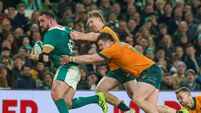The value of Victory
MY, haven’t times changed. When Malcolm O’Kelly trots out onto the Murrayfield turf in front of 67,000 people tomorrow evening he might take a second to remember his first encounter with the Leicester Tigers.
Thirteen years ago the professional game in Ireland was still stumbling around in the dark and almost two-thirds of the team that coach Ciarán Callan sent out for the Pool Two game that night (a Wednesday, strangely) were part-timers.
The Tigers would make it as far as the final three months later but rugby was still an off-Broadway production in those days and only 3,500 people decided the events at Lansdowne Road were worthy of their presence.
The only Leinster jerseys available back then were on the backs of the players, the notion of corporate hospitality was years away and the possibility of a World Cup-winning Springbok moving to Dublin would have been greeted with hilarity.
Even five years later, when Mick Dawson assumed the role as Leinster chief executive, the concentration was almost exclusively on what was happening on the pitch. No-one gave a thought about stadia or any of the myriad off-field practicalities.
Most of those issues were still in the IRFU’s domain but the tide of change in the game has swept every boat along with it. The provinces have had to adapt. Rugby is big business now and the figures prove it.
The IRB is looking for an £80m guarantee from countries looking to host the 2015 World Cup and this summer’s Lions tour will cost in the region of €12m. Hey, Leinster spend over €300,000 a year on travelling expenses alone. Clearly, professional rugby is no longer the cute, nervous puppy that stepped gingerly onto the wider sporting stage in the mid-1990s. It is a more mature entity, one that continues to grow, with an appetite to match.
Sporting glory isn’t the biggest prize in town tomorrow. Bucks are on the line, big bucks, even if there isn’t any pot of gold awaiting the winners of the Heineken Cup. The direct financial impact of becoming European champions is actually quite limited but the knock-on is incalculable.
Figures tend to multiply when trophies are raised aloft, although Leinster may have to wait a while to take full advantage of their European saga. The current kit deal with Canterbury runs for another three years while the tie-in with main sponsor Bank of Ireland continues through to 2011. That deal is worth €6m over four years and incorporates a sponsorship fee and support spend.
The impact of European success on season ticket sales will be more immediate. Leinster sold 9,000 for the current season and they have already moved just a thousand less for the 2009/2010 campaign. Season tickets are important to clubs as they offer a solid cash flow base and the hope is that they can sell 10,000, which would be pretty good, given the current economic climate. A win tomorrow would certainly help.
The sale of replica jerseys, and the royalties from them, should multiply. Reliable figures are difficult to obtain and the branch has dismissed one claim that 12,000 were sold in 2003.
As someone put it, there were probably more Bath jerseys in Dublin than Leinster back then, but recent anecdotal evidence is good. It is impossible to purchase one in parts of Dublin this week.
Silverware attracts sponsors too. Munster’s financial tie-ins has mushroomed since their first European title in 2006 and there will be no shortage of companies willing to hitch their wagon to a successful Leinster side in the capital.
Increased incomes will also mean greater clout when it comes to signing players, even if Leinster have already dug deep with the arrivals of players like Rocky Elsom and CJ van der Linde.
As things stand, the IRFU underwrites the costs of all the province’s players, giving the four branches a specific budget, but the individual outfits are perfectly entitled to fund any overspill themselves.
Leinster has ample room to grow as a brand too. Dublin remains its stronghold but the time is surely ripe to love-bomb the counties, particularly those which have hitherto had more of an empathy with Munster.
Mick Dawson accepts that last point but adds Leinster have long been attempting to break down the D4 stereotype and reach out to their traditionally indifferent country cousins.
Underage teams are habitually bussed up from more rural areas to play in the mini-rugby sessions during the interval at home games. Attractive ticket schemes have operated too.
The demographic of the season-ticket holders also suggests a greater interest from non-Dublin residents while the team boasts players from Meath, Louth, Wicklow, Wexford and Carlow as well as Dublin.
It all bodes well for the future, particularly as the perception is that the Irish provinces, or Leinster and Munster in any case, have been punching above their weight on the European stage.
“That’s a nice cliché,” says Dawson, “but I actually think that we have a lot of good players now. Munster are number one in Europe and Leinster are number three. Whether we are above our weight or not, we are certainly punching.
“International players here are remunerated as well as their English or French counterparts. You can’t compete with the likes of Toulon but, in relation to the Premiership where there is a salary cap, our international players are right up there.”
So too are the province’s attendances. Leinster were the best supported side in the Magners League for the last two seasons, thanks to concerted marketing campaigns like that aimed at selling home games as a family experience. Munster have begun to rival their neighbours in terms of bums on seats all season round thanks to the team’s perennial consistency and the attraction that is the redeveloped Thomond Park.
The Limerick venue offers a range of non-sporting facilities since its facelift, including corporate functions, museum tours and wedding receptions. As of now, the other provinces can do nothing but look on enviously.
Leinster’s situation is different. For a start, they are licence holders rather shareholders at the RDS and there are no cosy suites in which to watch the action in Ballsbridge.
That is not to say there are no corporate facilities. The Royal Dublin Showgrounds can cater for up to 500 corporate guests in some comfort on match days and the facilities are being upgraded on an ongoing basis.
A new pitch, floodlights and a new, covered stand have already been installed since Leinster’s arrival and planning permission has already been secured for work on the creaking Anglesea Stand which will include corporate boxes.
Next year will be the third of a deal that committed the province to a 20-year tenancy but that isn’t to say that Leinster won’t be availing of another exciting redevelopment project just down the road.
Says Dawson: “It is very exciting for us that Lansdowne Road is coming on stream (in 2010) because we could do something similar to what Stade Francais do, maybe take two matches a year there, pack it out.
“You could take a top Heineken Cup match and try to fill the ground. Our short-term ambition is to get up to 12,000 or 13,000 season ticket holders at the RDS and get the capacity there up above 20,000.
“We want to get to a situation like Leicester or Bath where people will go to the match just because Leinster are playing. .
“That is the kind of culture we want, the almost soccer culture. Success on the pitch will help breed that but you have to prepare for the day when the team isn’t as successful, when the supporters will drag the team along.”
Hopefully that won’t be for some time yet.















